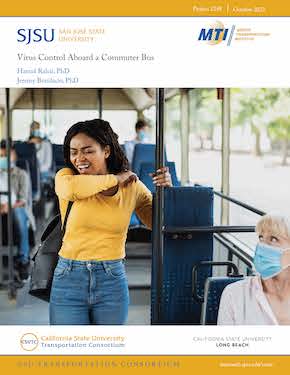- 408-924-7560
- mineta-institute@sjsu.edu
- Donate
Virus Control Aboard a Commuter Bus
A major health concern for public transit users is exposure to viruses from other passengers. This numerical study examines virus containment aboard a public bus with changes to the bus ventilation system. The virus was modeled as a 2.5 µm round solid particle released from the mouth of the infectious passenger at a rate of 21 particles per second at a mouth velocity of 0.278 m/sec. The air delivery to the cabin was two linear ceiling slots spanning the length of the bus delivering 59.38 m3/min (2,097 CFM) of air at a mean velocity of 1 m/sec. Two different axial and vertical linear exhaust slots placed on the side walls were investigated to examine how they affected virus containment and spread to the other parts of the cabin. Simulations were performed for both cases of the bus in transit and at the bus stop when the drop-off door was opened. Results indicate during transit that virus spread was contained to passengers sitting immediately in front of and behind the infectious passenger and the level of virus concentration could merit an increased risk of infection with increased virus residence time. However, augmented air mixing was observed between inside and outside air during the passenger drop-off with viruses spread to the front and back of the bus with reduced concentration and risk of infection. Analytical analyses of the risk of infection using the Wells-Riley equation were performed for the bus ventilation using 100% recirculating air without filtration, and 50% and 100% fresh air ventilation. Results indicate a high risk of infection when recirculating air is used, but the risk is reduced significantly with 50% and 100% fresh air ventilation. These results are critical to informing bus manufacturers, transit agencies, planners, and public transportation users about the potential of virus containment using a new ventilation system.
HAMID RAHAI, PHD
Dr. Rahai is a professor in the Department of Mechanical and Aerospace Engineering & Biomedical Engineering and Associate Dean for Research and Graduate Studies in the College of Engineering at California State University, Long Beach (CSULB). He has taught various classes at the undergraduate and graduate levels in thermal sciences; supervised over 70 M.S. theses, projects, and PhD dissertations; and published more than 90 technical papers. He has received over $13 million in grants and contracts from the National Science Foundation, Federal Highway Administration, California Energy Commission, California Air Resources Board, Port of Los Angeles, Caltrans, Boeing Company, and Southern California Edison, among others. He is the Engineering coordinator for the Caltrans new Local Technical Assistant Program (LTAP) and he director of the Center for Energy and Environmental Research and Services (CEERS) in the College of Engineering at CSULB which includes the Sustainable Engineering Training Academy (SETA) of the LTAP. He has been granted patents for the development of a high-efficiency vertical axis wind turbine (VAWT) and wind turbine apparatuses, and for reducing NOx emission of Cargo Handling Equipment using a Humid Air System. He also has pending patents related to a new conformal vortex generator tape for reducing tip vortices, an environmental artificial tree for reducing ambient NOx, and a new guide-vane enclosure for capturing wind energy from passing vehicles. Dr. Rahai is the recipient of the 2004 Northrop Grumman Excellence in Teaching Award and the 2012 CSULB Impact Accomplishment of the Year in RSCA Award. He received the Outstanding Engineering Educator Award from the Orange County Engineering Council in California in 2014, and in 2019 he was inducted as a senior member of the National Academy of Inventors (NAI).
JEREMY BONIFACIO, PHD
Dr. Bonifacio is a teaching professor and a senior researcher at the Center for Energy and Environmental Research and Services (CEERS) in the College of Engineering at California State University, Long Beach (CSULB). His expertise is in experimental and computational fluid mechanics. He has been involved in various applied industrial projects at CEERS and is co-owner of several patents related to emission control technologies and the application of CFD in diagnosing lung diseases. Dr. Bonifacio is the winner of the CSULB 2014 innovation challenge.
-
Contact Us
San José State University One Washington Square, San Jose, CA 95192 Phone: 408-924-7560 Email: mineta-institute@sjsu.edu






